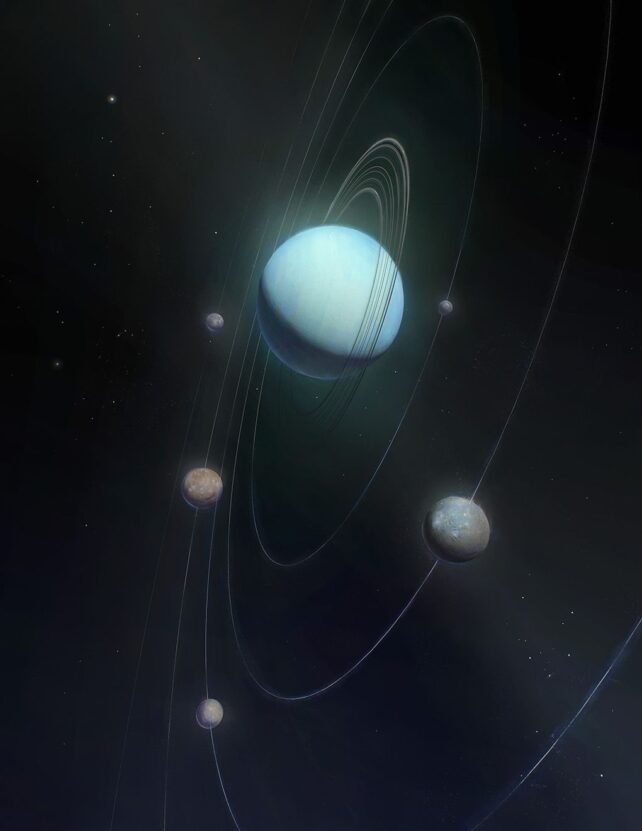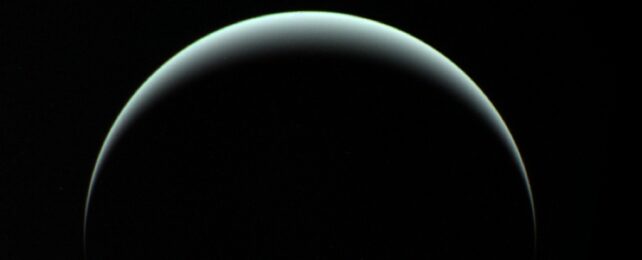There might be some hidden oceans lurking around Uranus.
New evidence suggests that one or two of the gas giant's 27 known moons might be harboring liquid oceans beneath their crusty rock-and-ice exteriors. The possible culprits for seeding the space around Uranus with plasma are Miranda and Ariel, one or both of which might be erupting with ocean plumes.
The data, which came from the Voyager 2 mission that flew past the planet on its way to outer space nearly 40 years ago – the only spacecraft ever to have done so – makes an excellent case for sending another probe to Uranus.
"We've been making this case for a few years now that energetic particle and electromagnetic field measurements are important not just for understanding the space environment but also for contributing to the grander planetary science investigation," says astronomer Ian Cohen of Johns Hopkins Applied Physics Laboratory.
"Turns out that can even be the case for data that are older than I am. It just goes to show how valuable it can be to go to a system and explore it first-hand."
Cohen and his team presented their findings on March 16 at the 54th Lunar and Planetary Science Conference, and a paper describing them has been accepted for publication in Geophysical Research Letters.
When Voyager 2 conducted its flyby of Uranus back in 1986, its Low-Energy Charged Particle instrument picked up something peculiar: charged particles that appeared to be trapped in specific regions of the Uranian magnetosphere. They should have spread out, but they remained confined to the equator, close to the orbits of Miranda and Ariel.
At the time, scientists believed that the peculiar profile was indicative of an injection of energetic electrons from a source such as a substorm in the magnetic field of Uranus. But on a closer look, Cohen and his colleagues found that the electrons don't exhibit the characteristics expected of a substorm injection.
This opened up a huge can of worms, because now the scientists were back at square one, trying to understand where the electrons came from. Of particular interest, they said, was the pitch angle of the electrons: the angle of their velocity vector relative to the magnetic field.
In order to maintain the pitch angle observed by Voyager 2, a constant source of electrons would be required, significant enough to overcome the scattering and loss that would occur due to plasma waves in the planetary magnetosphere.

Without a source of this nature, in the right spot and at the right angle, the team determined through modeling, the pitch angle distribution of the electrons would become uniform within mere hours.
Delving deeper into the Voyager 2 data, the team looked for such a source. Their modeling showed a clear and undeniable maximum in the space between Miranda and Ariel, suggesting a source of energetic ions in that region.
As for what could be generating those ions… well, in the 37 years since Voyager 2 visited Uranus, scientists have made some headway in that regard. Voyager 2 made a similar detection in the space around Saturn, discovered many years later in Cassini data to be generated by icy geysers on what we now know is an ocean moon, Enceladus. And another similar detection led us to Jupiter's ocean moon Europa.
"It isn't uncommon that energetic particle measurements are a forerunner to discovering an ocean world," Cohen says.
As to which of the moons it is – Miranda, the smallest of the five large moons of Uranus, or Ariel, the brightest – that's kind of 50-50 at this point. It could be either. Or both. Both moons show signs of relatively recent geologic resurfacing, which could be consistent with liquid material erupting from within.
But, so far, we only have the one dataset. Planetary scientists have been increasingly clamoring for a dedicated mission to Uranus, possibly with Neptune included. The planet has so many weird quirks that learning more about it could only be a genuinely exciting and rewarding experience.
The possibility of soggy moons is just icing on the stinky cake.
"The data are consistent with the very exciting potential of there being an active ocean moon there," Cohen says. "We can always do more comprehensive modeling, but until we have new data, the conclusion will always be limited."
The research was presented at the 54th Lunar and Planetary Science Conference, and has been accepted for publication in Geophysical Research Letters.
